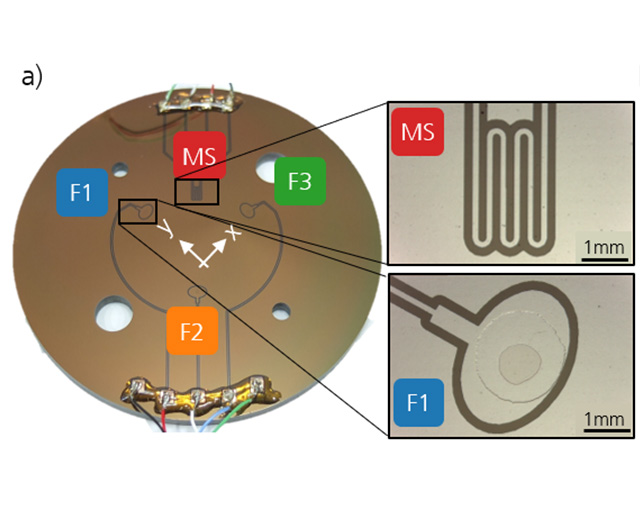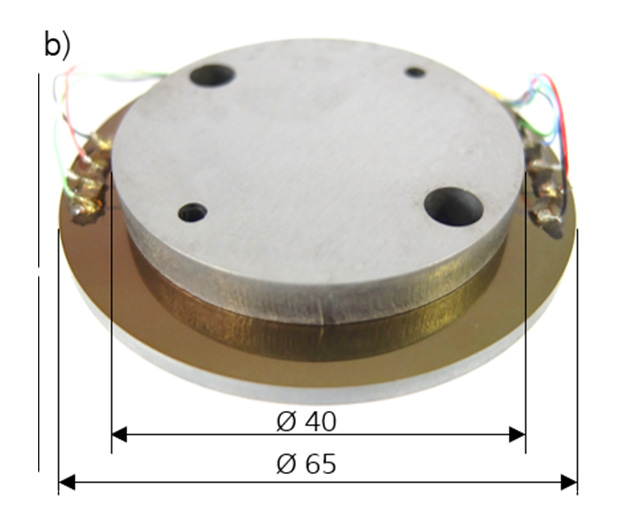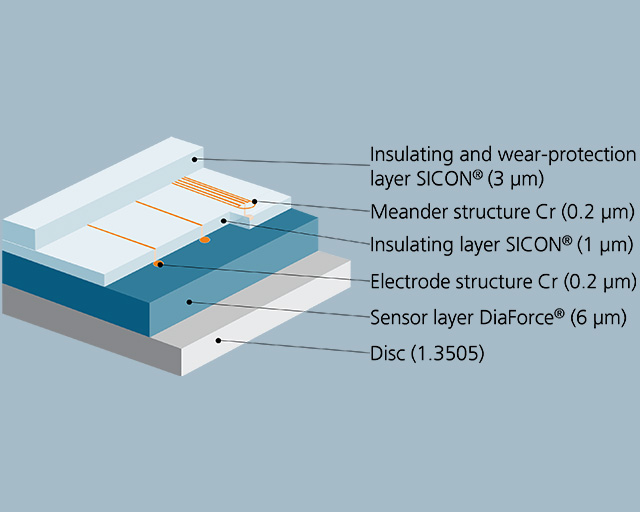
Thin-film sensors for force measurement in cold forging

The ecological and economical production of high-quality cold forged parts requires a high level of process reliability. The measurement of eccentric forces during the forming process plays an important role for the subsequent product quality and at the same time represents a major challenge. The Fraunhofer IST is therefore developing integrated and wear-resistant thin-film sensors to enable in-situ data acquisition. In combination with the use of artificial intelligence (AI), the measured data can be used to predict process conditions and product quality.

Force measuring disk for measuring axial forces during cup backward extrusion
The thin-film system is deposited directly onto the polished surface of a steel disk using physical and chemical vacuum deposition processes (PECVD). The piezoresistive sensor layer DiaForce® (6 µm) enables the measurement of normal forces and pressures at defined measuring points, which are designed as electrode structures. The electrical conductor paths are embedded between two electrically insulating layers of SICON® (1 to 3 µm) and, like the electrode structures, are manufactured from chromium using photolithography and wet chemical etching. The entire layer system has a thickness of approx. 10 µm. To ensure homogeneous pressure distribution over the sensor surfaces, two steel foils are positioned on the force measuring disk and pinned with a counter disk.
With the sensor design developed at the Fraunhofer IST, the axial forces occurring during forming are measured via the force measuring disks installed above the punch in the tool. With the help of forming simulations, which were calculated at the Institute for Metal Forming Technology in Stuttgart, it was possible to determine the optimum sensor positions for the development of the design. The force sensors (F1 to F3, see Figure below left and middle) are located on a circle that corresponds to the diameter of the forming punch. If required, the meander structure (MS) can be read out as a temperature sensor to record the temperature
Data-based prediction of concentricity in cold forging
The force measuring disk developed at the Fraunhofer IST with the integrated multifunctional thin-film system makes it possible to record the pressure distribution in the tool and thus to analyze the concentricity of the manufactured parts during impact extrusion. The force measuring disk was successfully used in both individual and continuous tests during the forming of steel blanks. Even after 160 strokes with an axial force of over 350 kN, no wear was detected on the loaded surfaces of the measuring disk. Based on the high quality of the recorded data, it was possible to train a suitable AI model that predicts the concentricity deviations for future processes. This enables individual quality control even before the part has left the machine.
Outlook
In the future, further experimental tests will be carried out to record measurement data in order to expand both the understanding of the process and the amount of data for further optimization of the AI models. The developed measuring element is to be validated for industrial use and set up as a demonstrator for interested partners. In addition, the collected findings offer the possibility of adapting the sensor technology for other industrial applications.
The project
The described results were achieved within the project ”MuWeKa - Multisensorische Werkzeuge für die Kaltmassivumformung” (Multisensory tools for cold forging) together with the Institute for Metal Forming Technology in Stuttgart and the Hahn-Schickard-Gesellschaft. The project was funded by the German Federal Ministry for Economic Affairs and Climate Action on the basis of a resolution of the German Bundestag and by the German Federation of Industrial Research Associations (AiF; IGF project number 21520 N).


